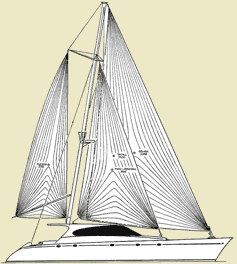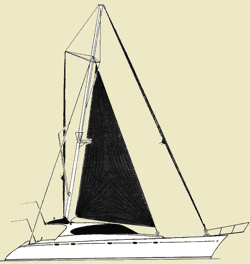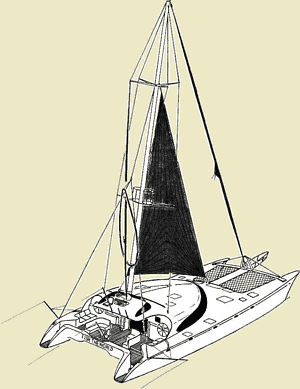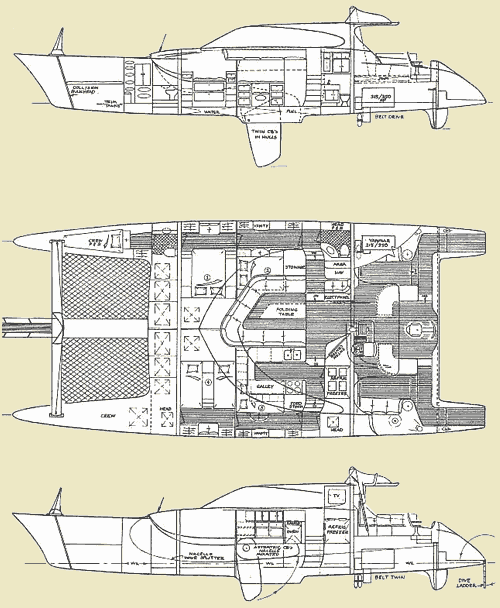
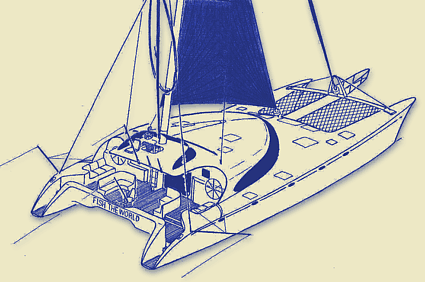
|
Fish
The World
The remoteness of these sites and their probable lack of facilities often preclude the use of most traditional craft. We need a vessel of true self-sufficiency, with capabilities of endurance and long range. The catamaran hull form has in the past couple of years gained significant recognition from both the power and sail industries as a truly efficient, sea-kindly hull form . There are monthly, many new converts praising the virtues of these multihulls. There is even a new magazine devoted to power multihulls. This efficiency factor under both power and sail is the key to long range. The long slender hulls of a catamaran are easily driven past the traditional displacement/hull-length resistance speed barriers, and this vessel's design has been optimized at a fineness ratio of 14 to 1 to ensure top performance. Twin diesel power of 350 hp each should drive her at 25 knots. Remember this is not a traditional displacement hull form, so it does not require excessive h.p. to 'get on plane'. A unique prop drive system contributes to this boat's efficiency. The props are not inclined to the water flow, but rather are directly aligned with it. This imparts an almost 100% thrust factor, and we can swing larger props as we're not limited by the traditional shaft inclination/length constraint. Many traditional sportsfishing boats are seen to be riding bow up at approx. 7 to 10 degrees. Add this angle to the shaft angles of 12 to 15 degrees, and we have props digging at the water between 19 to 25 degrees off true perpendicular; inefficient and prone to induce significant vibrations due to the unequal top to bottom hydrodynamic loadings. And upon hard backing-down, a tendency to power the stern of the vessel sharply down. This catamaran has its props further forward in a less vulnerable location, at the best inclination, and separated in width such as to offer excellent maneuverability. The propellers can be mounted either to the front or the rear of the strut in a pushing or pulling fashion, and the entire strut/prop mechanism can be made to retract (swing up) from the water while under sail and/or for servicing in remote locations. (Make reference to the Power Propulsion section of this website) The relatively small size of our engines, and the improved drive and hull efficiencies, make for a fuel miserly vessel that attempts to break the vicious circle of needing more fuel to power the higher h.p. engines needed to carry more fuel. This speed/fuel dilemma is discussed in an article in MARLIN, Feb-Mar '93. A more recent issue of MARLIN, Jan '95, makes a "head to head comparison" between a traditional 50' sportfisher, "Kelsey Lee" and a 50' catamaran vessel,"Tara Vana" over an identical, non-stop, 900 mile course from Costa Rica to Mexico; 1800 gals of fuel verses 320 gals for the cat (under power for the entire trip). And Tara Vana was able to fish the entire trip, unimpeded by the extra fuel containers which filled up the cockpit of Kelsey Lee. On another occasion, a voyage of 3700 miles was accomplished with the consumption of only 195 gals of fuel! [ The savings in fuel cost alone could defray a substantial portion of the crew salaries of this vessel in charter] Now if we add some sails to this vessel, we truly attain an unlimited range to fish the whole world on our own bottom. Lets keep this rig simple for non-sailors, and lets make sure it works in a fishing boat environment. I looked back at an old design of mine from 25 years ago. The basis of the idea was to develop a simple, efficient cruising rig ,which might be handled by as few as one person. Preferably this crewman did not have to leave the central cockpit area and/or over-exert himself in handling the sails. The rig needed to have good balance, in a variety of sail configurations which might be utilized in sailing the great variety of ocean and wind conditions it might encounter. Without going into details, this rig accomplished all those objectives, plus all of the sails simply roll up like old style window shades around their forward support wires (forestays). Very simply for non-sailors.
|
|||||
|
|||||
|
Gamefishing under sail? A great majority of the time spent actually fishing is done at trolling speeds (particularly so with the more recent popularity of flyfishing and light-tackle/stand-up styles). This catamaran can reach those trolling speeds under sail alone, in a silent, effortless, stable manner; and without having to use multiple sails. The single central sail (mainstaysail) is all that's needed to reach trolling speeds, and it can be rolled and stowed in 30 seconds or less, while the engines are engaged for exceptional maneuvering while landing the fish for tagging. I'm well aware that once a large gamefish is hooked, the vessel must get rid of all sail quickly, with minimum effort, and get under power. This unique vessel accomplishes that. And
how about the rigging of the sail plan interfering with the fishing?
Not much - look at perspective view. The wishbone boom swings
up, to stow totally out of the way while trolling. The entire
aft deck is clean except for the two backstays which broadly 'Y'
out to either transom. Two short pole outriggers can be swung
out from their stowed position up along side these backstays.
Its possible that this upside down 'V' formed by the backstays
could be rigged with additional trolling clip attachments. The
actual configuration of the fishing cockpit area may be altered
to suit the owner. Mr. Peter Wright, a very well known
name in offshore fishing around the world, has indicated that
he would be very pleased to help with the final configuration. Trolling
Configuration A more detailed description of this unique sailing rig was featured in some older issues of the magazines Yachting, Rudder, & Multihulls. The more recent update, "Revisiting the Mast-Aft Sailing Rig", has yet to be published. Both copies are available in the archives of this website. What a pleasure it is to move across the water under the silence of sail and be able to hold a conversation without shouting, and/or to listen to music without competing with the noise, vibration, & fumes of a pair of big h.p.diesel engines. Many people to whom I've talked, have emphasized this very negative aspect of charterboat fishing. I would urge any game fisherman to try, at least once, fishing under sail. I've also heard the many claims by various captains about their individual boat's particular sound being an attraction for raising fish. I find it difficult to believe that a very loud (water is a great amplifier and transmitter of sound), foreign sound would act to attract a large predator fish seeking out their food source in the ocean's natural environment. Loud, unnatural noises have in most cases acted to disperse aquatic life. Tara Vana, the only other professional sailing/gamefishing boat (catamaran) I know of, certainly excelled in the fishing tournaments off the Pacific island of Bora Bora (www.TaraVana.com). The sea-kindliness of some sportfishing boats is often considered secondary in the quest for speed. What many people forget about a smooth ride in a heavy sea is that it is very much a function of weight, in addition to hull design. The more weight a boat has, and the more form resistance (fat hull,etc.) it offers to moving thru the ocean, the more the sea acts to resist the boat's progress thru the sea, and thus the more uncomfortable ride and we must slow down. A big headsea is a particular challenge (the weak link you might say). Heavy boats carry their momentum into each trough and crest in a battle with the sea, while relatively lt-weight boats with slender hulls slice through with less battering. "You can out-think the ocean, but you can't out-slug the ocean," quoting a sign posted at the U.S. Naval Academy. In a beam or quartering sea, the monohull experiences a rhythmic rolling motion as it must first roll over in order to develop an anti-rolling force to roll back. Dampening of this motion is very slight, and the rolling is further exacerbated by a taller and/or heavier fishing tower. The catamaran has a much greater athwartship stability and roll dampening qualities; (and the sail acts to further dampen this roll, akin to the use of a steadying sail on an ocean trawler). Following seas tend to pick up broad sterns and slew the vessel off to either side of a straight course. Obviously, the catamaran form does not have these broad buoyant sterns. Storm survivability should be a consideration for any vessel making offshore passages, and its generally acknowledged, that this is best accomplished by facing into a truly strong storm (a big headsea). As mechanical things go, its not hard to imagine some lost of significant power at a most inopportune time during an extended storm. This could put the solely powered vessel in a perilous position in short order. The sail/ powered vessel of this proposal would only need to partially unfurl the rear (mizzen) sail, and the vessel will point up into the wind just like a weather vane on top of a barn. Add a sea anchor to this boat's inventory, and I would ride out a hurricane in this vessel. Enough of this sea stuff, lets look at the fun part. What a great boat to entertain family, friends, business associates, charter groups, etc. on, whether fishing or not. The catamaran offers immense areas in the cockpit, in the saloon/ galley, on the front tramp for relaxing, sunning, fishing, dining, socializing. The main saloon was divided into two large 'U'-shaped, galley and dinette/seating areas, and without partitions between them. This provides a spacious openness, with a panoramic view out the deckhouse windows. Including the galley in this social area is analogous to the situation at most land based home parties; the kitchen invariable becomes a center of the party. These areas could be opened up further, however at sea, I've found that one does not want too open an area, with limited things to hold onto and/or brace against. The nav station is conveniently located just inside the deckhouse entrance, and communicatively close to a major helm station. It also provides another seat in the social saloon.
|
|||||
|
|
|||||
|
What other 60/65' could provide 4 private dbl staterooms to the exclusion of any saloon conversion and two separate crew's quarters. Wow! The layout arrangement can be modified to fit an individual owner's requirements, but the basic premise was to locate all of the living areas (excluding crew) between the two major watertight bulkheads fore & aft. Versatility might dictate that the two most forward of these dbl. strms. be configured as two singles with removable inserts which convert them to doubles; or one might be converted to a very large owners bath. There's one other aspect of a cat that really adds to their fun. They have shallow draft! You can go exploring, many times right up to the shore. You can go where other boats only dream of; mangroves, rivers, coves. You can even beach the bows. You can fish the flats and reefs from the Bahamas to the Pacific atolls. This is a specialized vessel, which should appeal to that truly adventurous sportsman who desires to fish something other than organized tournaments, or that gentleman who desires to own a 'porsche of the seas'.
P.S. A sportsfishing vessel could also be operated as a fisheries research vessel. There are a number of colleges/universities (consortium) which could make shared use of such a vessel while the owner(s) co-benefit with usage time and tax considerations. Visit our Owner/Charter Options section. **Lest it be overlooked, this vessel's mission need not just be fishing. That may just be an ancillary feature of this very versatile world explorer. What a great Motor/sailer! |
|||||
"Trolling under power, sail, or a combination of both, Tara Vana easily fishes a spread of four lines and two teasers with another two light-tackle outfits rigged with natural baits.....With additional 10-ft outriggers she offers a huge lure spread."
"Under power alone Tara Vana has a respectable 1200-mile range, but thanks to her sail inventory and practical design she has virtually unlimited range."
"Tara Vana was designed to sail at nearly wind speed, and trolls very efficiently under sail alone..."
The designer " was asked to grapple with some of the unique requirements of a good sportfishing machine--the ability to back up quickly and maneuver with agility--then mesh them with a hull design that would not only perform well under sail, but also under power alone. The results are probably as close as anyone could come to the perfect compromise."
"She converts into a highly maneuverable powerboat in about as much time as it takes to drop a bait back and hook a billfish in her teasers, and once under diesel power, her widely separated, fully reversible props allow her to pursue even the most agile billfish with impressive agility."
"She backs down at over 10 knots without burying her two transom doors."
"Modern roller-furling sails roll up automatically like old-time window shades, ready for deployment at the pull of a line."
"Tara Vana features four staterooms, each with a queen-sized berth; and the main salon alone encompasses more space than virtually the entire interior of the" identical-size conventional vessel.
"What self-respecting powerboater would be caught dead on a sailboat? Well, a practical self-respecting powerboater, for one! Someone who wants to get to a fishing area reasonably fast, in spacious, stable comfort, with minimum fuel consumption, then live aboard comfortably in places lacking creature comforts and readily available fuel supplies, and fish effectively in virtually any sea state."
Rick Gaffney: A saltwater fly-rod world record holder, Capt. Gaffney has pursued big-game fish as an angler, charter boat captain, and photojournalist for well over 30 years.
Tara Vana: A custom-designed 50 ft gamefishing/sailing catamaran operating out of the Pacific island of Bora Bora.
